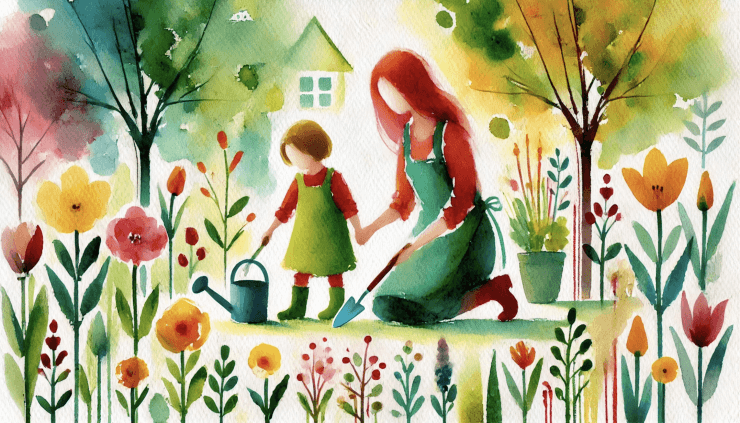Read by Matilda Longbottom

The first warm days of March are approaching, and soon I’ll be in the garden, tea in hand, surveying the Winter’s aftermath. This year, I’m especially excited because my seven-year-old daughter Ruby will be tending her very own raised bed – the one she started last year. Each Spring brings new discoveries as she grows from tiny garden helper into a budding horticulturist with an endless curiosity about every bug and flower she encounters.
I remember her first “help” in preparing the Spring beds – she couldn’t have been more than two. While I cleared dead stems and last year’s forgotten tomato cages, she toddled behind me, collecting twigs in her red plastic wagon. “Mess, Mama,” she’d say, pointing at the tangles of dried vines. “Clean up!” She was right, of course. Spring cleanup is the foundation of a healthy garden.
As the years passed, her contributions evolved with her abilities. At four, armed with her own child-sized rake, she learned the satisfaction of clearing Winter debris to reveal the first green shoots of returning perennials. By six, she was fascinated by soil preparation, insisting on helping me turn the compost into each bed. “The worms need highways,” she explained seriously, watching the dark organic matter disappear into the earth.
For new gardeners – or those teaching young ones – here are the essential steps for Spring bed preparation that Ruby and I have discovered together:
First, clear away Winter’s remnants. Remove dead plant material, fallen branches, and any forgotten tools or markers. This prevents disease and pest problems while giving new growth room to breathe. Ruby taught me that this task is more fun with a collection challenge: who can fill their bucket first?
Next comes soil assessment. We squeeze a handful of soil – if it compacts into a tight ball, it needs organic matter to improve drainage. If it falls apart completely, it needs compost to help it retain moisture. Ruby loves this test, treating it like a science experiment as she compares soil from different parts of the garden.
Turning the soil comes next, but gently. We’ve learned to work with nature, not against it. Instead of aggressive tilling that disrupts soil structure, we use broadforks and hand tools to loosen compacted areas while preserving beneficial fungal networks. Ruby calls these the “underground subway for plant food” after we read about how roots share nutrients.
Adding organic matter is crucial – a layer of compost, aged manure, or leaf mold worked into the top few inches of soil. This year, I’m curious to see what Ruby will think about different mulching materials. Will she choose straw for her strawberries, or perhaps try wood chips around her tomatoes? What will you use?
As I anticipate this year’s garden preparation, I’m excited to see what new interests Ruby will develop. Will she want to experiment with different companion planting combinations? Maybe she’ll develop her own theories about what helps plants grow best. Last year, she insisted on planting marigolds because she loved their bright colors – this year, I plan to teach her about their pest-deterrent properties, combining her natural aesthetic instincts with practical gardening wisdom.
Looking back, I realize that teaching Ruby about garden preparation has taught me just as much. Through her eyes, I’ve learned to see Spring cleanup not as a chore but as an opportunity for discovery. Each year brings new questions and new understanding. Her enthusiasm reminds me that gardening isn’t just about following steps – it’s about growing alongside our plants, learning from each season, and staying curious about the mysteries that unfold in our soil.
This Spring, I can’t wait to see what new insights Ruby will bring to our garden preparation routine. At seven, she’s at that magical age where curiosity and capability meet, where every garden task can become an adventure. Whatever she discovers, I know it will make our garden – and our relationship – richer. After all, the best gardens grow more than just plants; they grow knowledge, confidence, and connection, one season at a time. ❖
What are you looking forward to this year planting your garden? Is there someone special you get to share it with?


 Previous
Previous


